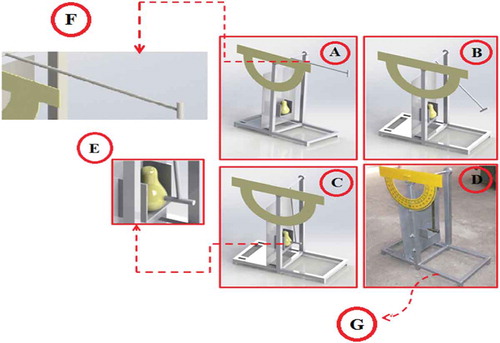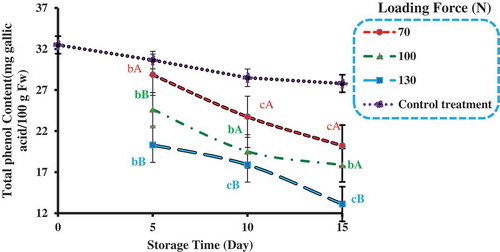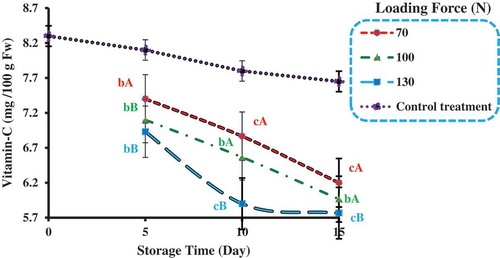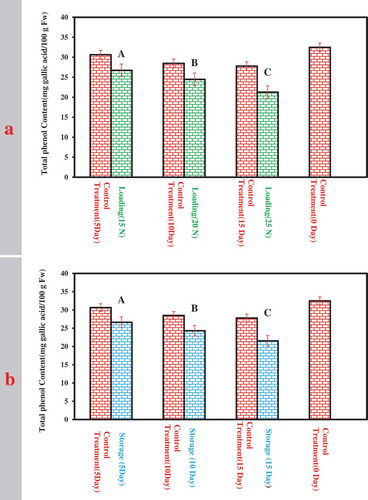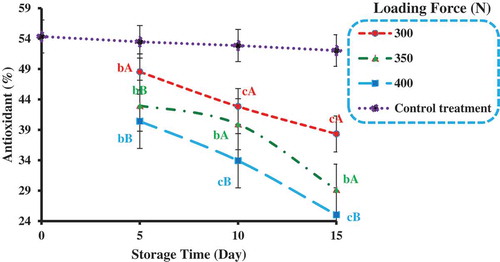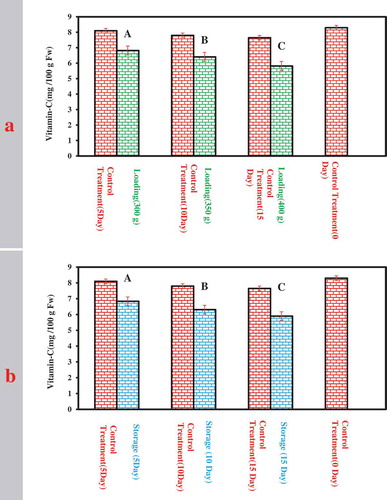 ?Mathematical formulae have been encoded as MathML and are displayed in this HTML version using MathJax in order to improve their display. Uncheck the box to turn MathJax off. This feature requires Javascript. Click on a formula to zoom.
?Mathematical formulae have been encoded as MathML and are displayed in this HTML version using MathJax in order to improve their display. Uncheck the box to turn MathJax off. This feature requires Javascript. Click on a formula to zoom.ABSTRACT
The present research investigated the effect of static and dynamic loading in various storage periods on the amounts of pears’ components like total phenol content, DPPH radical scavenging activity, and Vitamin C amount. in this investigation was subjected to static loading (thin-edge and wide-edge compression) using three different force and for dynamic loading using three weights in three different storage periods. Next, the total phenol content, percentage of antioxidant activity and vitamin C were measured. The results showed that the total phenol content, DPPH radical scavenging activity, and vitamin C rates were decreased with increasing force and weight loading and also with increasing storage period the amount of components were decreased. The amount DPPH radical scavenging activity, phenol compound and vitamin-C for control sample were 54.36%, 32.5 mg GAE/100 g and 8.3 mg/100Fw respectively, Also for wide loading and thin loading this amount was 35.56 and 37.56%, 13.11 and 21.29 mg GAE/100 g and 5.76 and 6.33 mg/100Fw respectively, For dynamic loading was 25.015%, 11.37 mg GAE/100 g and 5.82 mg/100Fw respectively. In general, the highest amount for the total phenol content, DPPH radical scavenging activity, and vitamin C obtained in thin-edge loading, also the wide-edge and dynamic loading had more effect on decreasing phenol and vitamin-C in pear during storage.
Introduction
Amongst many of the fruits, pears as a very excellent type of fruit have drawn the attention of the research and food industry for their properties. Pears are good sources of such components as antioxidants, phenol, anthocyanin’s and vitamin C. Pears’ varieties are commercial and very much liked varieties. Moreover, the use of antioxidant ingredients in fresh fruits has recently become of great importance for such a reason as their abundant effects in preventing diseases like cancer and cardiovascular ailments (Li et al., Citation2012). Various researches have also shown that the use of healthy fruits and vegetables in dietary regime can prevent the occurrence of diseases and it has been shown in the studies that there is a strong and inverse correlation between consumption of fruits and vegetables and the emergence of diseases. There are considerable amounts of evidence indicating the role of the antioxidants extant in the fruits and vegetables in the preservation of health and prevention of diseases. Phenolic compounds are capable of preventing low-density lipoprotein (LDL) from oxidation for their antioxidant properties and this causes the free radicals’ activities to be inhibited. Physiological characteristics of a product can be also explained (Galvis Sánchez et al., Citation2003; Lu et al., Citation2010). Furthermore, fruits and vegetables contain considerable amounts of active biological components featuring certain physiological and chemical performance that have been highly taken into consideration for their supply of the human needs (Tavarini et al., Citation2008). Antioxidants prevent chain oxidative reactions via enabling the donation of a hydrogen atom to free radicals by way of which oxidative process is delayed or controlled following which damage to the tissues will be prevented. Phenolic ingredients usually found in edible and inedible plants possess various biological effects like antioxidant, antimicrobial, anti-inflammatory, and other activities and the daily use of these ingredients causes a reduction in diseases. On the other hand, phenols are the largest photochemical group for their high frequency of presence in various plant-based foods. The group mostly includes phenolic acids and flavonoids. The foods’ phenolic ingredients considerably contribute to the antioxidant and anti-coagulation activities of the fruits and vegetables. Also, the synthesis of the phenolic ingredients in plants is influenced by various biological and non-biological stresses like UV, low temperature, scarcity of nutrients, insect attacks and so forth (Zhao et al., Citation2007). Mechanical damages can occur in predominantly three ways, named pressure, impact, and vibration or abrasion forces. The compressive force can be exerted by the pickers (fingers) during the harvest or under the pressure of the above-lying fruits in the boxes during storage. The external damages can occur due to the weight of the fruits accumulated in harvesting baskets, in deep boxes or when handling fruits using forks and rakes (Kupferman, Citation2006; Mohsenin, Citation1986). In fruit packaging stations, pressure, stroke, and vibration can occur during packing fruits in boxes or when washing and waxing the fruits. Compressive forces are usually imposed on fruits during transportation and storage. In the end, when fruits reach the market, some buyers use pressure on them to find out if they are ripened and fresh or not and this causes indentions in the fruits (Azadbakht et al., Citation2019).
There are many types of research done on the ingredients of the fruits, including the followings:
Afsharnia et al. (Citation2017) reported The effect of dynamic loading on abrasion of mulberry fruit and in this study firmness, total soluble solid (TSS), total anthocyanins content (TAC) and abrasion area were the measured factors. The result showed the TSS and TAC of immature and mature mulberry decreased during storage and increasing dropping height.
Ziaratban et al. (Citation2018) investigated the effect of storage period and loading on the phenol content, acidity and sugar in apple fruit and reported that the increase in storage period brings about reductions in acidity and sugar amounts and phenol content increased with increasing storage period. For loading, the increasing loading decreased the acidity amount and the loading not meaningful for phenol and sugar in apple fruit. Radovanović et al. (Citation2017) examined the relationship between the storage period and phenolic content and antioxidant activity in selected fruit extracts. The study results indicated that all fruit extracts exhibited fluctuations in total phenol contents with an initial increase after 4 days, followed by a decrease at both storage temperatures. These changes were not significant during 23 days of storage and the investigated fruit extracts can be used as an easily accessible source of natural antioxidants in food and pharmaceutical supplements.
Also, Navgaran et al. (Citation2014) experimented on the storage period of cherries and the study results indicated that the antioxidant rates of the fruits undergo decreases with the increase in the storage period (Navgaran et al., Citation2014).
The present study aims at the investigation of the quasi-static and dynamic loading effect in various storage periods on the amounts of total phenolic content, antioxidants and vitamin C contents of pears. This study shows that the problems during harvest and post-harvest are due to the bruise and economic losses and imposition of various loads during storage. The imposed loads are fruits’ compressing of one another (wide-edge quasi-static loading) as well as the damages and the forces imposed by box edges (thin-edge quasi-static loading) and fruits’ falling off the trees and/or forces exerted onto the fruits during handling and separation (dynamic loading). The present study results indicate what effects might each of these loads cause to the reduction in the internal components of the fruits as well as which type of stress imposed on the fruit might bring about the highest reduction on these components in pears.
Materials and Methods
Sample Preparation
Pears (Spadana variety) was purchased from the markets of Gorgan, Golestan province, Iran. Samples were taken to the laboratory of Gorgan University of Agricultural Sciences and Natural Resources. They were placed in an oven at 103°C for 16 hours and their moisture contents were measured (Azadbakht et al., Citation2016). The moisture content of the pears was calculated to be 77.92%.
Quasi-Static Test
To perform the wide and thin edge compression mechanical test, a pressure-deformation device (the Santam Inestrone -STM5-Made in Iran) with a load cell of 500 N was used. The compression test, where two circular plates were used, was performed at a speed of 5 mm/s with three forces of 70, 100, and 130 N and three repetitions. In this experiment, the pear was horizontally placed between the two plates and pressed, with the duration of the measurement recorded. Concerning thin edge compression test, we designed a double-jaw of plastic with a rectangular cross-section dimension of 0.3 × 1.5 cm. The test was performed at a speed of 5 mm/s with three forces of 15, 20, and 25 N and three repetitions (). By moving the movable jaw, the pressure operation was carried out until the force reached the desired level (Razavi et al., Citation2018).
Figure 1. Static quasi-load diagram of pear

Dynamic Loading
First, the pendulum and the required masses were made in a workshop in Gorgan Biosystem Mechanics Group (). The fruits were placed in the desired position and then the device arm (arm length = 33.5 cm) was raised to the desired angle (90°), and in the controlled state of the arm impact the pear. The pendulum had a 200 g arm and three different attachment masses of 100, 150, and 200 g for knocking. It should be noted that air resistance and friction were neglected through this procedure (Azadbakht et al., Citation2018). For the impact test, the pendulum system was built (). The distance between two beams was equal to the length of the pivot axle was 21.5 cm. The length of the pendulum arm (height of pendulum axle to the center of weight was 27.3 cm. There is a gap in sample support that held the pods vertically.
Evidence (Control) Treatments
Six pears for each period and zeroth day were selected to evaluate and compare the experimental data for each of the total phenolic contents, DPPH radical scavenging activity and vitamin C. The first control group was called zeroth day, the first day before loading and storage, the pears content (phenol content, antioxidant activity, and Vitamin C) was measured. Then, besides measuring the internal components of each of the pears subjected to loads, the contents of the evidence pears that had only been storage were evaluated during each specified period. The evidence pears were labeled 5-day, 10-day, and 15-day evidence pears, respectively.
Biochemical Properties Measurement
To measure the total phenol content and the percentage of free radicals’ neutralization, specimens equal to 0.5 gram of each sample’s wet callus was ground and homogenized using 5 milliliters of methanol 80% (for a 1:10 ratio) in a cold mortar. The homogenized mixture was placed on a shaker device in a dark room for 24 hours and then subjected to the centrifugal force in 3000 rpm for 5 minutes. The upper part of the extract was used for measuring the biochemical characteristics.
Percentage of Free Radicals Neutralization Based on DPPH Method
In this experiment, the percentage of DPPH free radicals neutralization was measured based on the method proposed by Bandet et al. (Citation1997). At first, 2 milliliters of DPPH with a concentration of 0.1 millimoles (4 millig of DPPH in 100 milliliters of methanol) was admixed to the experiment tube and 2 milliliters of the prepared methanolic solution was next added thereto following which the experiment tubes were placed in a dark environment and the absorption rates were immediately read using spectrophotometer in 517-nm wavelength. The evidence specimen contained 2 milliliters of DPPH and 2 milliliters of methanol. Methanol was applied to calibrate the spectrophotometer. The figures outputted from formula (2) substitutions were converted to neutralization percentages(Li et al., Citation2012).
As- specimens absorption rates
Ac = evidence specimen absorption rate
Total Phenol
Folin-Ciocalteu (F-C) method and Gallic acid standard were used to measure the total phenol content. To do so, 20 microliters of methanolic extract (0.5 g in 5 ml 80% methanol) was mixed with 100 microliters of F-C and 1.16 ml of distilled water following which 300 microliters of 1molar sodium carbonate (10.6 g in 100 ml of distilled water) was added thereto after 8-minute resting time. The aforesaid solution was placed in a vapor bath, 40°C, in a dark room for 30 minutes. In the end, the specimens (Device model 2800 UV/VIS) were read in 765-nm wavelength. (Jaramillo-Flores et al., Citation2003).
Vitamin C
Vitamin C amounts were calculated using the indophenol titration method in such a manner that 5 g of the sample was mixed and extracted using 40 milliliters of citric acid 8% in the first stage. Then, 10 ml of the filtered extract was picked up and mixed with 40 milliliters of citric acid 8% and subjected to titration using indophenol reagent. The termination point of titration was the appearance of a pale purple that lasted for about 15 s. The Vitamin C amount is expressed in milligram per 100 gram of the sample weight. Vitamin C amount can be obtained by formula 2 (Jaramillo-Flores et al., Citation2003).
Statistical Analysis
Samples were stored for 5, 10, and 15 days after quasi-static and dynamic loading, Total phenol content, DPPH radical scavenging activity, and vitamin C were measured. All experiments were performed in three replications and the results were analyzed using a factorial experiment in a completely randomized design with SAS statistical software.
Results and Discussion
Static Loading
presents analysis of variance (ANOVA) results for the effect of loading force (Wide and Thin edge) and storage period on Total phenol content, DPPH radical scavenging activity and vitamin C. Accordingly, the average operation was performed with the LSD test.
Table 1. Analysis of variance (ANOVA) results for the effect of loading force (Wide and Thin edge) and storage period on Total phenol content, antioxidant activity and vitamin C
Wide-Edge Loading
According to the , the loading force and storage period had significant effects in a 1% level on the total phenol, DPPH radical scavenging activity, and vitamin C content. Moreover, considering the results, the Interaction effects of loading force and storage period on the total phenol content and vitamin C were found statistically significant in a 5% level and the insignificance of Interaction effect was evidenced for DPPH radical scavenging activity. Also, considering the significance of the Interaction effect of total phenol content and vitamin C for thin-edge loading, mean comparisons were made using the least significant difference (LSD) test the results of which have been illustrated in and .
DPPH Radical Scavenging Activity for Wide-edge Loading
depicts the effect of the loading force and storage period on DPPH radical scavenging activity. It can be expressed according to the figure that DPPH radical scavenging activity has undergone a decrease subject to loading and storage. Furthermore, it can be seen in the figure that the reductions in evidence (control) pears’ DPPH radical scavenging activity are almost close to one another but the increase in loading and storage causes a reduction in DPPH radical scavenging activity. Based on , the highest DPPH radical scavenging activity, 54.36%, was obtained on the first day and the evidence pears’ DPPH radical scavenging activity reached 52.05% on day 15 post-storage. But, it can be observed that the reduction in DPPH radical scavenging activity subject to loading and storage is higher than the reduction in DPPH radical scavenging activity in normal storage modes. Upon the increase in loading force values, DPPH radical scavenging activities were found decreased by 16.46%, 24.46% and 33.09% for 70, 100 and 130 N compressive forces, respectively, as compared to the first-day evidence treatment.
Figure 3. (a): The effect of loading force and (b: storage period on DPPH radical scavenging activity of pear in the wide edge pressure. In A section same letters indicate the non-significance in loading. In B section same letters indicate the non-significance in storage period

Antioxidants are ingredients that prevent oxidation reactions stemming from free radicals in vegetable and fruit tissues and the antioxidant capacity of the fruits pertain to their enzymatic and non-enzymatic ingredients like vitamin C, total phenolic compounds, carotenoids and so forth (Spinardi, Citation2005). Therefore, the reason for the reduction in the ingredients like DPPH radical scavenging activity is the stress imposed on the product. Herein, the imposed stress was compressive forces exerted onto the pears that brought about a reduction in the amounts of total phenolic compounds and vitamin C (Torres et al., Citation2010). The results found herein are inconsistency with what was obtained by Ferreyra et al. (Citation2007) for strawberries (Ferreyra et al., Citation2007).
Total Phenol Content for Wide-edge Loading
displays the Interaction effect of loading force and storage period on the total phenol contents of the pears. The increase in storage causes a reduction in phenol content for fixed loading values. The highest and the lowest phenol contents were 28.8603 (70 N loading force and 5-day storage period) and 13.1197 (130 N loading force and 15-day storage period), respectively. Additionally, comparison of the phenol content of the evidence pears with the pears subjected to loading and storage period indicated that the latter pears have undergone a considerable decrease in their phenol contents. According to , the highest phenol content of Spadana Variety evidence pears has been 32.5 mg/100 gf.w and it was found reduced to 27.8 mg/100 gf.w on the day 15 of the storage period. Also, the total phenol content of the compressed and then stored pears was found intensively reduced so it can be stated that the increase in the loading force and the 15-day storage period brings about reductions in the total phenol content equal to 37.77%, 45.04% and 59.633% for 70 N, 100 N and 130 N loading forces, respectively, in respect to the first day. Moreover, the total phenol content was only 14.46% for the evidence pears after the day 15 post-storage. The results obtained herein are similar to the findings of Dastjerdi et al. (Citation2014) on the total phenol content of mangoes for the specified storage period (Dastjerdi et al., Citation2014).
Vitamin C for Wide-edge Loading
demonstrates the Interaction effect of loading and storage period on Vitamin C content. The vitamin C content was found decreased in pears with increasing the loading force and storage period in separate. The highest and the lowest vitamin C contents were 7.4 (70 N loading force and 5-day storage period) and 5.7667 (130 N loading force and 15-day storage period). According to , the highest vitamin C content of Spadana Variety evidence pears was 8.3 mg/100 gf.w that was found reduced to 7.65 mg/100 gf.w after 15 days of storage. Also, the amount of vitamin C for the pears was found intensively reduced subject to loading forces and storage so it can be stated that the increase in loading force and loading period up to 15 days brings about reductions in Vitamin C contents of the pears by 25.30%, 28.12% and 30.53% for 70 N, 100 N and 130 N loading forces, respectively. Furthermore, the total phenol content of the evidence pears was only 7.83% on day 15 of the storage period. Also, considering the imposed stress and the internal damage of the product, there is documented an increase in the biological activities as the possible cause of the increase in Vitamin C decomposition hence reduction in Vitamin C content during the storage period.
Thin-Edge Loading
According to the , the loading force and storage period had significant effects in a 1% level on the total phenol, DPPH radical scavenging activity, and vitamin C content. Moreover, considering the results, the interaction of loading force and storage period on DPPH radical scavenging activity was found statistically significant in a 5% level and the non-significance of interaction were evidenced for the total phenol content and vitamin C. In addition, considering the significance of the interaction of DPPH radical scavenging activity for thin-edge loading, mean comparisons were made using least significant difference (LSD) test the results of which have been illustrated in .
DPPH Radical Scavenging Activity for Thin-edge Loading
demonstrates the interaction of loading and storage period on DPPH radical scavenging activity. DPPH radical scavenging activity was found decreased in pears with increasing the loading force and storage period in separate. The highest and the lowest DPPH radical scavenging activity were 51.5% (15 N loading force and 5-day storage period) and 37.566% (25 N loading force and 15-day storage period). According to the obtained results, the increase in the loading force causes an increase in DPPH radical scavenging activity reduction. Besides, subject to a specified loading force, the increase in the storage period causes an increase in DPPH radical scavenging activity reduction. Based on the obtained results, DPPH radical scavenging activity reductions by 19.31, 23.56 and 30.90 were scored subject to 15 N, 20 N and 25 N loading forces in respect to the first day’s DPPH radical scavenging activity, i.e. evidence pears. DPPH radical scavenging activity reduction was only 4.24 for the pears that were not imposed with loading forces. The trends of the antioxidant activity variation observed for the specified storage periods are possibly pertinent to the changes in the amounts of the ingredients possessing antioxidant activity the result of which is an alternation of the metabolic activity and respiration intensities during the storage period. The reduction in DPPH radical scavenging activity/capacity during storage period can be associated with the size and texture of the crop, as well (Patthamakanokporn et al., Citation2008). Prior reports are indicative of the idea that DPPH radical scavenging activity of the fruits is reduced during storage. Ferreyra et al. (Citation2007) showed that the reduction in DPPH radical scavenging activity of strawberries during storage originate from the reduction in such ingredients as Vitamin C, Flavonoids and total Phenolic Compounds (Ferreyra et al., Citation2007).The results of the study by Navgaran et al. (Citation2014) indicated that the antioxidant capacity of cherries is reduced with the elongation of the storage period (Navgaran et al., Citation2014).
Total Phenol Content for Thin-edge Loading
displays the effect of the loading force and storage period on the total phenol contents of the pears. The increase in storage causes a reduction in phenol content for fixed loading values. The highest phenol contents were in 5 days storage (26.74 mg/100 g FW) and for loading force in 15 N (26.63 mg/100 g FW). Also, according to the results, the increase in loading force reductions in total phenol by 17.72%, 24.70% and 34.48% were evidenced in contrast to the evidence treatment pears’ phenol content (zeroth day) while the phenol content reductions for 5-day, 10-day, and 15-day evidence treatments have been 5%, 12%, and 14%, respectively, also in comparison to zeroth day evidence treatment. The reduction in total phenol content can be attributed to the breaking of the internal cell structure that comes about the following ripening in the storage (Ghasemnezhad et al., Citation2010). Stresses like external loads accelerate the cell structure breakdown following which phenol content is reduced. The activity of phenylalanine ammonia-lyase (PAL) has also been found effective in phenolic ingredients’ reductions because the enzyme is provoked by various biological and non-biological stresses as a consequence of which phenolic acids and flavonoids pile up in the fruit. PAL is a primary enzyme taking part in phenolic ingredients’ synthesis. The activity of the foresaid enzyme is directly related to the amounts of phenolic ingredients in such a manner that the increase in phenolic ingredients can be associated with the increase in PAL activity. Thus, the reduction in phenolic compounds during storage and subject to loads can be attributed to the activity of this enzyme stimulated in environmental stresses (Ghasemnezhad et al., Citation2010; Zhao et al., Citation2007).
Vitamin C for Thin-edge Loading
displays the effect of loading force and storage period on Vitamin-C contents of the pears. The increase in storage causes a reduction in Vitamin-C contents for fixed loading values. The highest Vitamin-C contents were in 5 storage (7.46 Mg/100 g FW) and for loading force in 25 N (7.24 Mg/100 g FW) and The lowest Vitamin-C contents were in 15 storage (6.33 Mg/100 g FW) and for loading force in 25 N (6.58 Mg/100 g FW)
Figure 8. (a): The effect of loading force and (b): storage period on the Vitamin-C in the Thin edge pressure
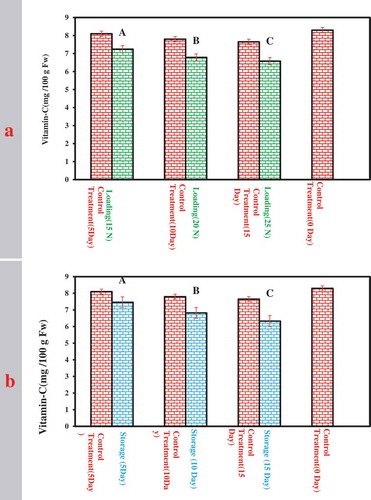
Also, according to the results, the increase in loading force brings about reductions by 12.72%, 18.21% and 20.72% in vitamin C contents in comparison to that of the evidence treatment (8.3 GAE/100-zeroth day) while phenol content reductions in 5-day, 10-day and 15-day evidence treatments were 2.4%, 6% and 7.8%, respectively, that are indicative of reductions as compared to those of the 0-day evidence treatment so it can be stated based on the obtained results that the Vitamin C reduction is due to the dehydration of the interior parts of the fruit texture which per se causes Vitamin C oxidation and reduction. These results comply with the finding of Tavarini et al. (Citation2008). (Zhao et al., Citation2007).
Dynamic Loading
presents the results of variance analysis of the effect of the amount impact and storage period on the total phenol, DPPH radical scavenging activity and vitamin C contents for dynamic loading. According to the , the amount of impact and storage period had significant effects in a 1% level on the total phenol, DPPH radical scavenging activity, and vitamin C content. Moreover, considering the results, the interaction of amount impact and storage period on DPPH radical scavenging activity and total phenol content were found statistically significant in a 5% level and the non-significance of interaction was evidenced for vitamin C. In addition, considering the significance of the interaction of DPPH radical scavenging activity and total phenol content for dynamic loading, mean comparisons were made using least significant difference (LSD) test the results of which have been illustrated in and .
Table 2. Analysis of variance (ANOVA) results for the effect of dynamic loading and storage period on Total phenol content, antioxidant activity and vitamin C
DPPH Radical Scavenging Activity for Dynamic Loading
demonstrates the effect of loading and storage period on DPPH radical scavenging activity. DPPH radical scavenging activity was found decreased in pears with increasing the amount of impact and storage period in separate. According to , the highest DPPH radical scavenging activity in the control samples was 54.36% on day zero and after 15 days of storage, DPPH radical scavenging activity in control pears reached 52.05%. The highest DPPH radical scavenging activity for dynamic loading was during 5 days and the impact weight 300 g (48.541%) and the lowest amount during the storage period was 15 days and the impact weight 400 g (25.015%). But, it can be observed in Figure. that the reduction in DPPH radical scavenging activity is higher subject to loading and storage than a reduction in DPPH radical scavenging activity in normal storage mode. The increase in loading causes reductions by 29.48%, 46.34% and 53.98% in DPPH radical scavenging activity for 300 g, 350 g, and 400 g loading forces in contrast to the first-day evidence (Control) treatment.
Total Phenol Content for Dynamic Loading
displays the interaction of loading impact and storage period on the total phenol contents of the pears. The increase in storage causes a reduction in phenol content for fixed loading values. The highest and the lowest phenol contents were 26.465 m/100 g FW (300 g weight and 5-day storage period) and 11.37 mg/100 g FW (400 g weight and 15-day storage period), respectively. The increase in loading force caused reductions by 69.54%, 75.22% and 79.08% in the total phenol content subject to 300N, 350N and 400N impact loading in contrast to the first-day evidence (Control) treatment.
The phenomenon can be justified as follows: the increase in the weights brings about an increase in the physical damage percentage of the pears as a subsequence to which the amounts of phenolic ingredients are increased in the cell wall and the internal texture is exposed to air hence browning of the texture due to polyphenol oxidase (PPO) catalysis that is followed by the reaction of the total phenolic contents released during impact with oxygen (Li et al., Citation2012).
Vitamin C for Dynamic Loading
displays the effect of loading force and storage period on Vitamin-C contents of the pears. The increase in storage causes a reduction in Vitamin-C contents for fixed loading values. The highest Vitamin-C contents were in 5 storage (6.82 Mg/100 g FW) and for loading force in 300 g (6.84 Mg/100 g FW) and the lowest Vitamin-C contents were in 15 storage (5.9 Mg/100 g FW) and for loading force in 400 g (5.84 Mg/100 g FW). Also, according to the results, the increase in the loading force caused reductions in Vitamin C content by 17.83%, 22.71% and 29.87% as compared to that of the evidence treatment (8.3 mg/100 g F.W-day zero) while the vitamin C content reductions for 5-day, 10-day, and 15-day evidence treatments have been 2.4%, 6% and 7.8% which are indicative of reductions in contrast to those obtained for the 0th day evidence treatment. Also, Vitamin C possesses protective effects against the formation of free radicals and occurrence of various diseases due to its antioxidant properties but it becomes rapidly oxidized due to its specific structure and it is usually destroyed in storage periods. The destruction speed of Vitamin C is largely dependent on packaging type, its color and storage and physical conditions of the fruits. The intactness of the fruit surface, storage temperature, amount of dissolved oxygen as well as the packaging materials’ rate of permeability to oxygen are factors influencing the Vitamin C destruction speed (Burdurlu et al., Citation2006; Kabasakalis et al., Citation2000). Moreover, the pears’ surfaces had been damaged to some extent subject to dynamic loading and this same issue had provided for their reaction with oxygen giving rise to Vitamin C content reduction during storage.
Conclusion
According to the statistical results, for thin and wide-edge, the storage period had affect more than loading force on the antioxidant activity components change of pears except the phenol content in thin-edge loading, also for dynamic loading, the storage period had affect more than loading force on all components except vitamin-C. The total phenol content, DPPH radical scavenging activity, and Vitamin C content have been decreased with increasing loading force (in static and dynamic loading) and storage period and for loaded fruit than control sample in dynamic loading, the amount total phenol content, DPPH radical scavenging activity, and Vitamin C content are decreased 65.01%, 53.98% and 29.87% respectively, And for wide-edge loading, the components are decreased 59.66%, 34.58% and 30.60 respectively, Also for loaded fruit than control sample in thin-edge loading, the components are decreased 34.49%, 30.90 and 20.72 respectively. The highest total phenol content, DPPH radical scavenging activity, and Vitamin C content decreasing obtained in dynamic loading and afterward wide-edge and thin-edge loading had the most decreasing. In generally, the highest amount for the total phenol content, DPPH radical scavenging activity, and vitamin C obtained in thin-edge loading, also the wide-edge and dynamic loading had more effect on decreasing phenol and vitamin-C in pear during storage.
References
- Afsharnia, F., S. A. Mehdizadeh, M. Ghaseminejad, and M. Heidari. 2017. The effect of dynamic loading on abrasion of mulberry fruit using digital image analysis. Information Processing in Agriculture. https://doi.org/10.1016/j.inpa.2017.07.003.
- Azadbakht, M., H.R. Moghbeli, and M.V. Torshizi. 2019. Investigating the various effects of pear packaging box design factors subject to stress forces. Int. J. Fruit Sci. doi: 10.1080/15538362.2019.1573161.
- Azadbakht, M., M. Vahedi Torshizi, and M.J. Mahmoodi. 2018. The use of CT scan imaging technique to determine pear bruise level due to external loads. Food Sci. Nutrition (August):1–8. doi: 10.1002/fsn3.882.
- Azadbakht, M., M.V. Torshizi, and A. Ziaratban. 2016. Application of Artificial Neural Network (ANN) in predicting mechanical properties of canola stem under shear loading. Agri. Engg. Int. 18(5):413–424.
- Bondet, V, W Brand-Williams, and C Berset. 1997. Kinetics and mechanisms of antioxidant activity using the dpph free radical method. Lebensmitt Wissenschaft Technologie Journal of Food Science and Technology 30:609–615.
- Burdurlu, H.S., N. Koca, and F. Karadeniz. 2006. Degradation of vitamin C in citrus juice concentrates during storage. J Food Eng 74(2):211–216. doi: 10.1016/j.jfoodeng.2005.03.026.
- Dastjerdi, A., N. Morad, E. Rezazadeh, and M. Heidari. 2014. Effect of salicylic acid and storage time on quality of mango fruits (Mangifera indica L.). J. Plant Produc. 37(1):27–36.
- Ferreyra, R.M., S.Z. Viña, A. Mugridge, and A.R. Chaves. 2007. Growth and ripening season effects on antioxidant capacity of strawberry cultivar Selva. Sci. Hortic. 112(1):27–32. doi: 10.1016/j.scienta.2006.12.001.
- Galvis Sánchez, A.C., A. Gil-Izquierdo, and M.I. Gil. 2003. Comparative study of six pear cultivars in terms of their phenolic and vitamin C contents and antioxidant capacity. J. Sci. Food Agric. 83(10):995–1003. doi: 10.1002/jsfa.1436.
- Ghasemnezhad, M., M.A. Shiri, and M. Sanavi. 2010. Effect of chitosan coatings on some quality indices of apricot. Cjes 8(1):25–33.
- Jaramillo-Flores, M.E., L. González-Cruz, M. Cornejo-Mazón, L. Dorantes-álvarez, G.F. Gutiérrez-López, and H. Hernández-Sánchez. 2003. Effect of thermal treatment on the antioxidant activity and content of carotenoids and phenolic compounds of cactus pear cladodes (Opuntia ficus-indica). Food Sci. Technol. Int. 9(4):271–278. doi: 10.1177/108201303036093.
- Kabasakalis, V., D. Siopidou, and E. Moshatou. 2000. Ascorbic acid content of commercial fruit juices and its rate of loss upon storage. Food Chem. 70(3):325–328. doi: 10.1016/S0308-8146(00)00093-5.
- Kupferman, E. 2006. Minimizing bruising in apples. Washington State University.
- Li, W.L., X.H. Li, X. Fan, Y. Tang, and J. Yun. 2012. Response of antioxidant activity and sensory quality in fresh-cut pear as affected by high O2active packaging in comparison with low O2packaging. Food Sci. Technol. Int. 18(3):197–205. doi: 10.1177/1082013211415147.
- Lu, H., H. Zheng, H. Lou, L. Jiang, Y. Chen, and S. Fang. 2010. Using neural networks to estimate the losses of ascorbic acid, total phenols, flavonoid, and antioxidant activity in asparagus during thermal treatments. J. Agric. Food Chem. 58(5):2995–3001. doi: 10.1021/jf903655a.
- Mohsenin, N.N. 1986. Physical properties of plant and animal material. (revised) Gordon and Breach science publishers New York.
- Navgaran, K.Z., L. Naseri, and M. Esmaiili. 2014. Effect of packaging material containing nano-silver and silicate clay particles on postharvest. J. Food Res. 24(1):89–102.
- Patthamakanokporn, O., P. Puwastien, A. Nitithamyong, and P.P. Sirichakwal. 2008. Changes of antioxidant activity and total phenolic compounds during storage of selected fruits. J. Food Composition Anal. 21(3):241–248. doi: 10.1016/j.jfca.2007.10.002.
- Radovanović, B., A. Radovanović, V. Nikolić, N. Manojlović, and J. Dimitrijević. 2017. Storage Effect on Phenolic Content and Antioxidant Activity in Selected Fruit Extracts 49(4):879–883.
- Razavi, M.S., A. Asghari, M. Azadbakh, and H.-A. Shamsabadi. 2018. Analyzing the pear bruised volume after static loading by Magnetic Resonance Imaging (MRI). Sci. Hortic. 229(June2017):33–39. doi: 10.1016/j.scienta.2017.10.011.
- Spinardi, A.M. 2005. Effect of harvest date and storage on antioxidant systems in pears. Acta Hortic. (682):135–140. doi: 10.17660/ActaHortic.2005.682.11.
- Tavarini, S., E. Degl’Innocenti, D. Remorini, R. Massai, and L. Guidi. 2008. Antioxidant capacity, ascorbic acid, total phenols and carotenoids changes during harvest and after storage of Hayward kiwifruit. Food Chem. 107(1):282–288. doi: 10.1016/j.foodchem.2007.08.015.
- Torres, L.M.A.R., M.A. Silva, D.G. Guaglianoni, and V.A. Neves. 2010. Effects of heat treatment and calcium on postharvest storage of atemoya fruits. Alimentos E Nutrição Araraquara 20(3):359–368. http://serv-bib.fcfar.unesp.br/seer/index.php/alimentos/article/viewArticle/1128.
- Zhao, X., E.E. Carey, J.E. Young, W. Wang, and T. Iwamoto. 2007. Influences of organic fertilization, high tunnel environment, and postharvest storage on phenolic compounds in lettuce. HortScience 42(1):71–76. doi: 10.21273/HORTSCI.42.1.71.
- Ziaratban, A., M. Azadbakht, and A. Ghasemnezhad. 2018. Changes in physiological parameters and the apple stiffness due to the static and dynamic impacts. Journal Of Agricultural Engineering 41(3):97–111.

